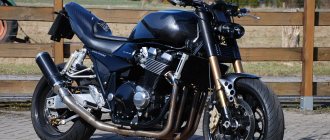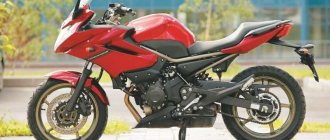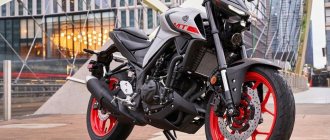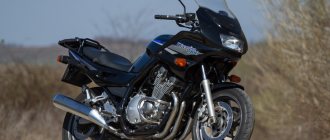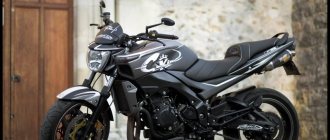Sports motorcycle Yamaha YZF-R6
Yamaha's YZF-R6 is the bike I've been waiting for. Among other things, because I had never ridden an R6 before, and there were a lot of good things to hear about this bike. How does it work in everyday use? Will it live up to expectations and hopes for it? In this article I will try to answer all these questions.
The YZF-R6, at first impression, is not much different from what it is. Let's start with a brief summary. This bike is definitely dedicated to sport. Of course, you can ride around the city or along the route, but the bike is definitely better and deserves more. The R6 is a car that handles best outside of town. It is fast and fully equipped. Regular “legal” city driving on it is simply tiresome. But you can easily find your bank position on the trail and make full use of this bike.
Motorcycle Yamaha YZF-R6
Brief history of the model
Model
: Yamaha YZF-R6 (Europe, North America, Australia).
Factory designation
: 5GV1, 5GV2, 5GV3, 5EB1, 5EB2, 5EB3.
Model
: Yamaha YZF-R6 (Europe, North America, Australia).
Factory designation
: 5GV4, 5GV5, 5GV6, 5EB5, 5EB6, 5EB7, 5EB8.
Model
: Yamaha YZF-R6 (Europe, North America, Australia).
Factory designation
: 5MT1, 5MT2, 5MT3, 5MT4, 5MT6, 5MT7, 5MT8, 5MT9, 5MTA.
Model
: Yamaha YZF-R6 (Europe, North America, Australia).
Factory designation
: 5MTB, 5MTC, 5MTD, 5MTE, 5MTF, 5MTG, 5MTH.
Model
: Yamaha YZF-R6 (Europe, North America, South Africa, Australia).
Factory designation
: 5SL1, 5SL2, 5SL3, 5SL4, 5SL5, 5SL7, 5SL8, 5SL9.
Model
: Yamaha YZF-R6 (Europe, North America, South Africa, Australia).
Factory designation
: 55SLB, 5SLC, 5SLD, 5SLE, 5SLF, 5SLH, 5SLJ.
Model
: Yamaha YZF-R6 (Europe, North America, Japan, Australia).
Factory designation
: 5SLS, 5SLR, 5SLW, 5SLV, 5SLX, 5SLN, 5SLM, 5SLP, 5SLT, 5SLU.
Model
: Yamaha YZF-R6 (Europe, North America, Japan, Australia).
Factory designation
: 4P61, 4P62, 4P63, 2C01, 2C02, 2C03, 2C05, 2C06, 2C07, 2C08, 2C09, 2C0A.
Model
: Yamaha YZF-R6 (Europe, North America, Japan, Australia).
Factory designation
: 4P64, 4P65, 4P66, 2C0B, 2C0C, 2C0D, 2C0F, 2C0G, 2C0H.
Model
: Yamaha YZF-R6 (Europe, North America, Japan, Australia).
Factory designation
: 4P68, 4P69, 13S1, 13S2, 13S4, 13S5, 13S6, 13S8, 13S9, 13SA.
Model
: Yamaha YZF-R6 (Europe, North America, Japan, Australia).
Factory designation
: 4P6A, 4P6B, 4P6C, 13SB, 13SC, 13SH, 13SJ, 13SK, 13SG, 13SM.
Model
: Yamaha YZF-R6 (Europe, North America, Japan, Australia).
Factory designation
: 13SL, 13SR, 13SS, 13ST, 13SU.
Model
: Yamaha YZF-R6 (Europe, North America, Japan, Australia).
Factory designation
: 13SV, 1JS5, 1JS1, 1JS6, 1JS2, 1JS7, 1JS3, 1JS8.
Model
: Yamaha YZF-R6 (Europe, North America, Australia).
Factory designation
: 1JSL, 1JSG, 1JSP, 1JSR, 1JSD, 1JSA, 1JSE, 1JSB, 1JSS, 1JSF, 1JSC, 1JSL.
Model
: Yamaha YZF-R6 (Europe, North America, Australia).
Factory designation
: 1JSU, 1JSV, 2CX1, 2CX2, 2CX3.
Model
: Yamaha YZF-R6 (Europe, North America, Australia).
Factory designation
: 2CXB, 2CX4, 2CX9, 2CX7, 2CX8.
Model
: Yamaha YZF-R6 (Europe, North America, Australia).
Factory designation
: 2CXE, 2CXL, 2CXJ, 2CXK.
Model
: Yamaha YZF-R6 (Europe, North America, Japan, Australia).
Factory designation
: 1JSY, 2CXM, 2CXY, 2CXU, 2CXW, 2CXX, 2CXS, 2CXT.
Model
: Yamaha YZF-R6 (Europe, North America, Australia).
Factory designation
: BN64, BN63, BN61, BN62.
Model
: Yamaha YZF-R6 (Europe, North America, Japan, Australia).
Factory designation
BN6A, BN6D
Model
: Yamaha YZF-R6 (Europe, North America, Australia, Japan).
Model
: Yamaha YZF-R6 (Europe, North America, Australia, Japan).
Price for Yamaha YZF-R6 motorcycle
Today, the price of a Yamaha P6 motorcycle ranges from 12,000 to 13,000 dollars for a new motorcycle, and from 4,000 to 7,000 dollars for a used car, depending on the year of manufacture, condition and mileage.
There is a direct connection between the very first Yamaha motorcycle and the modern R6. This connection is Yamaha's dedication to the Kando tradition and unwavering design philosophy. Simple and lightweight, compact and powerful are the main criteria that guided the company when creating the YZF-R6. This machine was able to combine all the qualities necessary for lovers of fast motorcycles. And if it is not ideal, it is very close to ideal.
From music to motorcycles, for over 100 years, Yamaha has maintained its unique way of thinking, which combines ancient Japanese philosophy with human emotion, and continues to influence motorcycles and musical instruments with the Three Crossed Tuning Forks logo.
Model dimensions
If we talk about the weight of the Yamaha YZF R6, then the model is relatively light . Its weight reaches only 166 kg. A lightweight diamond-shaped frame made it possible to achieve this figure, which adds additional speed and aerodynamics to the bike. The dimensions of the model look like this:
- length – 204 cm;
- width – 70.5 cm;
- height – 110 cm.
Specifications
By releasing the 600cc and 1000cc models in parallel, Yamaha engineers applied the most advanced technologies to both of them. The bike turned out to be not only balanced, but also incredibly powerful, and its technical characteristics can put almost anyone to shame. If compromises are not your thing, but a liter sportbike seems too big and heavy for you, the Yamaha YZF R6 will be the perfect option for you.
Engine
The engine that was originally installed in 2001 was slightly modified, and then acquired an injector along with four carburetors. Subsequently, it was modernized several more times, receiving an inertial charging system that adds power at high speed, different operating modes and an increased compression ratio. At the same time, the power ultimately did not increase, but even decreased slightly - in the first generation it is 120 hp, and in the last - 118.4 hp, and it is achieved at around 13000-14500 rpm. Torque ranges from 68 to 61 Nm, it is available at 10500-12500 rpm, so the engine needs to be constantly revved. Acceleration to 100 km/h takes only 3 seconds! At the same time, the maximum speed of the R6 is only slightly inferior to that of the YZF-R1, officially amounting to 260 km/h.
Transmission
The modern 6-speed transmission with slipper clutch works perfectly, shifting gears is easy and very precise. At the same time, the gearbox foot has a short stroke, which may at first seem unusual for motorcyclists who have switched from another vehicle. And it’s worth keeping in mind that the YZF-R6 is more demanding when it comes to choosing the right gear than the YZF-R1. After all, how many cubes do they both have? That’s the difference - with a smaller volume, the engine has to be turned more actively, and the gearbox has to be worked more often.
Chassis and brakes
The alloy Deltabox frame with a lightweight swingarm has been changed several times, but on any generation of the motorcycle it is completely consistent with its time. The suspension is fully adjustable both front and rear, and since 2005 an inverted fork has been installed. The brakes are very grippy; the front wheel has two discs (from 298 to 320 mm) with 4-piston calipers, and the rear wheel has another 220 mm disc with a 1-piston caliper (on older models, with a 2-piston caliper). ABS is only available on motorcycles 2021 and younger.
Electronics
Older copies have little electronic filling, but the younger the bike, the more there is. Starting in 2021, there are even more electronics due to the addition of auxiliary traction control systems and selection of engine operating modes. For diagnostics, you need to connect the motorcycle to a laptop with special software via the CAN bus.
Weight and dimensions
The curb weight ranges from 182 to 190 kg, but in any case remains low. Despite its not too low center of gravity, the R6 doesn't feel heavy and is very easy to handle. The compact dimensions also make a positive contribution, thanks to which the bike feels like a fish in water in dense city traffic.
Controllability
All generations of the Yamaha R6 handle superbly, and in the city they feel even more confident than the “liter” ones, thanks to their more modest dimensions and comparable dynamics. In reviews and feedback from owners, complaints arise only about the 2005-2006 models, which, according to pilots, have a tendency to skid the rear wheel during sudden braking.
Fuel consumption
This parameter directly depends on the year of manufacture (more precisely, on the generation) of the motorcycle, its technical condition, operating conditions and riding style. Modern injection R6s from 2018 consume an average of 5.6 liters per 100 km, and for some R6 from 2003 this parameter will be a liter and a half more, especially if you drive aggressively. Tank volume is from 17 to 17.5 liters, depending on the generation.
What else about YZF-R6
We can open the stove, but we won't go there. The steps don't fill me with confidence, but it's probably a standard item where Yamaha is saving a ton. It's thin, and I don't recommend riding a motorcycle in a basement. Classically, as with the Yamaha, you will find many accessories for this motorcycle. The tester I drove had the optional door handle and exhaust tip. You can see this in the videos I linked below. However, it should be remembered that it does not correspond to the norm and is dedicated only to the track.
All special accessories and a detailed description of the motorcycle can be found on the manufacturer's website.
I see the bike as an interesting option for people looking for a new sport 600. But with strict application to the track. I wouldn't recommend it for the city. Well, unless someone is pushing hard for the R6, then I think they will be happy with the way this bike rides and performs. Because I haven’t done such a calm sport for a long time. Everything is smooth here, vibrations are practically not transmitted. This bike glides forward with the grace of a driver's seat while remaining the evil little personification of
Below are some technical data, video review and photos of the bike. I also suggest you watch the videos that show this bike.
| engine's type | 4-stroke, liquid cooled, DOHC, forward tilt, in-line, 4-cylinder, 4-valve |
| capacity | 599 cm3 |
| Maximum power | 118.4 hp at 14,500 rpm |
| Maximum torque | 61.7 Nm at 10500 rpm |
| total length | 2040 mm |
| Overall Width | 695 mm |
| Overall height | 1 150 mm |
| Saddle height | 850 mm |
| Operating weight | 190 kg |
| Fuel tank capacity | 17 liters |
Post Views: 3,252
Repair and tuning
How often you will have to spend money on your two-wheeled friend, and how much money will be spent, greatly depends on the operating conditions of the motorcycle. If you drive as usual, then you will spend less, but with regular races on the track, repairs and maintenance will require completely different amounts.
Repair
The Yamaha YZF R6 is not highly maintainable, and many components in it, in the event of a breakdown, can only be replaced and not repaired. This results in the high cost of maintaining the model and the complexity of many service operations. In addition, the latest generations of sport bikes contain a lot of complex electronics, which only experienced mechanics with a laptop and special software can understand. To carry out full diagnostics, you need to connect the “brains” of the bike to a computer and analyze all the data.
Spare parts
The compatibility of spare parts between different generations of a motorcycle is far from 100%, and it is often difficult to find the necessary parts for old Yamaha YuZF R 6. Everything is available to order, but the price may surprise you. But there are few non-original spare parts, despite the popularity of the model and the fact that the market is full of non-original consumables. Their quality ranges from excellent to dismal.
Tuning
The range of available tuning is huge, it includes both cosmetic elements and purely technical ones. Refining the transmission, strengthening the engine, upgrading the brakes - whatever you want, there would be enough money. Moreover, most of this stuff is offered by third-party manufacturers, and not by Yamaha itself.
Suspension in YZF-R6
The rear cupid was designed from scratch for this model. At the front we have the suspension from R1. Full customization of all operating parameters. In other words, another sign that this is a paving machine and not a block pushing machine. From the very beginning of riding this bike, I hated tracks, intersections and any inequality on the road. I felt them with my whole being.
Yamaha YZF-R6
Yamaha R6, top sports motorcycle
Yamaha R6, sportbike 600
The king of motorcycles from the golden period of the sport of the 600 series. The Yamaha R6 debuted in 1999 and immediately made the womb go wild, even among the male group. A beautiful, light, compact and very sharp sports car. The halls were buzzing - Yamaha had done a great job and this period was undoubtedly theirs.
The R6, although slightly heavier than the Gixx, offered 5 hp more. more, he loved to take turns and roared at the same time as in rage. To achieve this, it has an excellent braking system and good suspension.
It was only after minor shortcomings emerged that high performance was paid for with less reliability. Poor transmission design, i.e. the two dropping out, has plagued Yamaha to this day. In addition, high mileage engines liked to “drink” oil while driving (without stopping in place). There is a lot of used R6 motorcycles on the market - however, buying a well-maintained copy is more difficult, but if you manage to do it, you may fall in love with it.
Post Views: 17,663
Clock in YZF-R6
What deserves a world cup in the “we did it well” category is the watch of this bike. A classic large clickable speedometer with switch does the job. I don't know why this is going away, but this is how speedometers and tachometers on motorcycles should be. Not only because they look beautiful, but also because they are megabit. Nothing breaks like a thin, invisible rotation bar. Well, that's probably another suggestion for using a motorcycle: ideas about mileage, speed, mileage, combustion and hours are standard. Classic genre. Plus controls all the evils and systems extracted from the rev counter of the rev counter. DIAMOND!
YAMAHA F6CMHS EU NOW ON ANY SIDE.. (Views: 1)
Go to page
Go to page
In general, we are talking about the hypothetically assumed. But 25 km/h on the seventh propeller is already a full slipper. On the eighth - gas at 3/4 and speed 27-28 with a TOTAL weight (boat-27, motor-28, gasoline-4, skipper-86 with things?) of about 155-160 kg.. Consumption is no longer 2.2 l/h, and no more than 1.5-1.6 l/h, which, believe me, is closer to the real one. Those. 40-45 minutes on the tank at a speed of even 27 km/h. Then count. In any case, my estimated 15-20 km (and even more) per 1.1l is quite realistic. Your 8.8 liters per 100 km is also, you agree, not bad. But for some reason, on the water, few people think so (per 100 km). Mileage is less than on asphalt. And the conditions - today there is one load, wind, etc. , tomorrow another one. About 25 km/h on the seventh propeller and a keel boat, my personal opinion is hardly. And further. It is somewhat easier to disperse a punt in calm conditions and small ripples. Where do you get your knowledge from? Good luck.
vladimir07
vladimir07
The other day, the two of us walked against the current on 1.5 liters for 20-25 km. In my opinion, a wonderful expense.
Yes, the consumption is wonderful. Let me clarify: together - how much in kg? Screw 8? What speed? Still 20 or 25 km? The difference is significant.
———- Message added at 00:13 ———- Previous message posted at 00:05 ———-
Now the same boat runs at a maximum speed of not 23-24 but 30-31 km/h (propeller at 8 1/4 pitch). And it lifts two people onto the glide quite easily. And max. The weight put on the planing (boat+motor+crew+gasoline+anchor+things) is about 270 kg, i.e. 45 kg per horse, but this is already with a wing and a punt boat (propeller with 7″ pitch). .
How much does your boat lift on planing with an 8 1/4 pitch propeller?
———- Message added at 00:16 ———- Previous message posted at 00:13 ———-
vladimir07
That is, with an 81/4 pitch propeller, the boat can hardly lift 238 kg on the glide and the maximum speed is 24 km? With a 7-pitch propeller and a wing, the boat can glide 270 kg and reach a maximum speed of .
Motorcycle modifications
The sportbike has changed several times, and now the seventh generation is being sold in dealerships, which will be released in 2021. Below are the main changes to the model by year:
- Yamaha R6 2001. A lot of minor changes to the engine, affecting pistons, connecting rods, ignition and much more. They were considered successful, and the 2002 Yamaha R6 was produced in exactly the same form.
- Yamaha R6 2004 model year (production actually began in 2003) acquired an injector instead of carburetors, as well as an updated appearance.
- Yamaha R6 2006. Another deep restyling with creatively recycled plastic and an engine with increased power (up to 127 hp). The modernization also affected other elements - exhaust, headlight, gas tank, injector and gearbox. The clutch became slippery and the mechanical throttle was replaced with an electronic one. The ignition system has also been completely replaced with a new one. There were some minor flaws, but in the Yamaha R6 2007 they were all corrected.
- In 2008 and 2010, restylings were carried out, but there were no significant changes in the technical part.
- The 2021 Yamaha R6 has received the most profound changes in the model's history. The design was completely redesigned, the bike received a new suspension, stronger brakes, an aerodynamic body kit, auxiliary electronic systems and much more.
Main advantages of the model
Among the reasons why the R6 Yamaha has gained wide popularity are:
- electrically adjustable throttle;
- an inverted fork;
- powerful engine with 129 horsepower;
- excellent handling;
- good aerodynamics.
You may also be interested in: World-famous Yamaha motorcycles: a review of legendary models
Appearance
If I don't like the R1 (I just don't like it, and although the truth looks better in real life, there are some that I'm present for), then the R6 has even won my heart. It looks aggressive, like a bad motorcycle straight out of hell. Here the lights on the new Yamaha look much better than those on the R1. They are not so simple and are more like logs. By the way, they beautifully decorate the road. The bike itself looks great. The high-suspension Passenger backrest, inspired by Ducati, creates a striking and aggressive look. You can see that this bike is not just a toy for wild rides on the track. He's really cool, at least in my opinion.
Yamaha YZF-R6
Position, comfort on the YZF-R6
One of the biggest issues for me with this bike is the tank. And basically its shape is on the steering wheel. When paired with athletic gloves that have heavy padding on the wrists, it may be impossible to perform slow maneuvers that require heavy steering. You simply cannot control the steering wheel and the brake, or the clutch and the brake, at the same time. I had this in my Handroots. In other gloves the problem was less serious, but also occurred. I spent 3 days looking for my position and got used to it. There was pain in the wrists and spine. This bike is just low and very sporty. It doesn't feel easy when riding slowly, but on the highway you'll have perfect control. And basically, as I wrote earlier, this bike is made for this.
The passenger also doesn't have an easy seat because he sits high behind the driver and doesn't do much of holding up as much as leaning on him. Zadupek backpack is high. The passenger of filigree height has problems with the driver's grip and basing on the tank. It should slide off the seat to give the driver more confidence. As a result, after 50 km there is a problem with leg numbness. Besides, leave someone somewhere, it's not really a trip. You can't buy a new friend's affection just by having an R6
Yamaha YZF-R6
Hit parade
I deliberately omitted the story about the operation of the transmission of the compared motorcycles, since they do not differ in anything special. Perhaps the gearbox of a Honda sportbike deserves a special mention... No, not for the amazing clarity of gear shifting, for which vehicles of this brand have always been famous, but because of the gear ratios that differ from the YZF-R6 and F3, which for me personally were not obvious and even unnatural. For example, if the turn before the finish line on Yamaha and MV Agusta motorcycles was comfortable to take in second gear, then on the Honda machine it was a little lacking, and there was a desire to go down to first... Which was too little, and the engine was suddenly driven by one deft movement left foot into the red zone of the tachometer, tearfully begging to quickly return to second gear.
As I already wrote, coupled with the “smooth” and even overly friendly engine, this created the false impression that the motorcycle simply “didn’t move,” to put it more simply! In reality, everything rested precisely on the obviously elongated transmission ratios, because of which, by the way, the Honda CBR600RR developed the highest maximum speed on the stand! True, only on the stand... On the track, the MV Agusta F3 turned out to be faster than others on long straights. My personal hit parade of sportbike braking systems looks like this: F3, CBR600RR, YZF-R6. The Italian motorcycle is equipped with front brake discs of the largest diameter, as well as truly incomparable radial 4-piston monoblock calipers from Brembo...
I think comments are unnecessary here. The Honda CBR600RR is the only one of the test vehicles that was equipped with ABS. And, of course, not a simple one, but a combined one, which the Japanese concern uses, it seems, on all motorcycles, with the exception of cross-country and enduro models (although I’m sure it will get to them someday...). Despite the not the most effective Tokico 4-piston front calipers, the presence of an anti-lock braking system greatly simplifies control over the braking process, and, of course, makes it more dynamic. Press releases dedicated to the update of the CBR600RR model say that Japanese engineers have worked a lot on the C-ABS control electronics and made it more responsive to the moment of wheel stall, so that the system does not interfere with the pilot’s control of the motorcycle on the race track... But this is still not the case . The operation of ABS is noticeable under almost every braking, which is especially noticeable due to the absence of the notorious slipper clutch on the CBR600RR. Unfortunately, there is no opportunity to configure or at least adjust ABS on a Honda motorcycle, as it can be done, for example, on a BMW HP4... But this, however, is a completely different motorcycle, from another planet and for different money.
The performance of the YZF-R6 braking system is also at the level, and there was never a situation where it was not enough. Although there is no anti-lock braking system, the good old Sumitomo 4-piston calipers, terminated at the other end of the reinforced line by a Brembo radial machine, provide the driver with good front-wheel feel and allow precise timing of the initiation of braking. And everything would be fine, but the brakes of the Yamaha sportbike have two fatal problems that did not allow me to place the “resourceful” YZF-R6 in second, or even more so, first place in the hit parade. The names of these problems are Honda and MV Agusta. The Japanese counterpart “outdoes” the competitor with the presence of C-ABS, and the Italian device proudly bears nice mechanisms, painted golden and decorated with the word Brembo.
Price of Yamaha YZF 600 R6 according to sales advertisements
The maximum price of Yamaha YZF 600 R6 among the advertisements found is RUB 504,000*
The average price of Yamaha YZF 600 R6 among the ads found is RUB 298,000*
The minimum price of Yamaha YZF 600 R6 among the advertisements found is RUB 225,000*
Yamaha YZF 600 R6 in Rostov-on-Don
02/12/2020 237,000 rub.
Yamaha YZF 600 R6 (40A) in Salekhard
02/10/2020 227,000 rub.
Yamaha YZF 600 R6 2003 in Bor
05/28/2019 225,000 rub.
Yamaha YZF 600 R6 2011 in Ufa
11/06/2016 RUB 504,799
* Attention! Under the maximum, average and minimum of the Yamaha YZF 600 R6 motorcycle on this page, the average cost according to advertisements for sale on the Internet is indicated, without taking into account the year of manufacture, configuration and generation of the motorcycle model.
Honda CBR 600 F4i
Honda CBR 600 F4i, Honda 600cc
Motorcycles up to 600cc. The CBR 600 F4i is the least sporty bike on our list today - it's the only one with a full bench - although F4 fans can also buy the S version, which is sportier looking and a kilo lighter.
The 600cc CBR engine gives us 109bhp of power and is one of those engines on which Honda has built its reputation for reliable motorcycles. Yes, you can complain about the timing belt tensioner or voltage regulator - but these are minor things. There are a lot of good things to say about these engines and machines because many people choose these devices to perform their stunts.
Don't be fooled by the convenient layout of the controls - the F4i, as befits a sports segment, can accelerate to 250 km/h. The motorcycle is also ideal for everyday use, it is not afraid of motorways, as well as exits to the track - although it is not specifically made for riding. This fact has not stopped Honda from conquering the market, and currently among the used cars is the CBR.
FAQ
- How noticeable is the difference in dynamics compared to the R1? At speeds up to 150-170 km, the difference is near zero, and it can be attributed to the reaction time of the pilots themselves. At higher speeds, the YZF-R1 begins to confidently pull ahead.
- I want to ride on the track and race at sea in the summer for a couple of thousand kilometers. Is this model right for me? Doubtful, unless you are a masochist. Some people even ride 50cc scooters across Russia, but this bike is not designed for long rides. Most drivers, after several hours behind the wheel, begin to ache in their back and arms, which are subjected to high loads due to a purely sporty riding position.
- Is it possible to turn off assistance systems like traction control? I don’t like it when technology tries to think and make decisions for me. It is possible, but it is not recommended. Japanese engineers are by no means fools, and they installed all this for a reason.
Test drive YamahaYZF-R6
How it was…
1998.
In the fall, a new model from Yamaha was shown in Munich, a real revolution in the 600 class. Instantly putting its main competitor, the Honda CBR 600, on two shoulders, the Yamaha R6 became the sportiest bike. The lightest, most powerful in the class, the shortest wheelbase, the best brakes, an elegant rear with an LED light, a removable mudguard with space for a number, they clearly said that this motorcycle does not suit numbers. Compared to the R6, the competitors' 600s looked like road warriors. The Yamaha R6 follows the same path of ultra-sportiness that its “big sister” R1 paved a year ago.
The competitors realized that they had missed the mark and rushed to catch up: in a couple of years, the Kawasaki ZX6 and Suzuki GSXR 600 improved in power, lost weight, and Yamaha’s advantage began to melt away. It's time to update!
2001. The weight of the motorcycle has been reduced by 1.5 kg, there are new pistons, and minor changes have been made to the electrical equipment.
2003. In general, a new motorcycle with a modernized engine and a new chassis was released. Fuel injection instead of the throwback carburetors is the most memorable change. Motorcycles are now called “injection” or “carburetor” in conversations. Together with the injection, 3 hp were added, and the “diet” allowed me to lose another 5 kg.
2005. Among the clearly visible changes: an “inverted” fork, among the invisible ones - a different angle of inclination, a different radiator, new levers in the rear suspension to change the progression. Naturally, all improvements are designed to improve handling, which was not satisfactory before.
2006. Completely new motorcycle. None of the competitors have “Six Hundred” of this level. The first thing that catches your eyes and ears is the engine, which “spins” up to 18,000 rpm and produces 133 hp. Fantastic! Such a rev range is a Formula 1 privilege. To obtain such characteristics, the designers had to make an “ultra-short-stroke” engine with titanium valves, a direct-flow muffler and a tuned intake. There is no hiding that the R6 was built for the race track, to win in the Supersport class. Suspension with low and high speed damping adjustment is a pure racing necessity. Until now, you would not have seen such a suspension on anyone, even at the World Championships, because changing the fork is prohibited by the regulations. Now Yamaha has this homologated package, which makes everyone swallow their saliva even before the start. But what can we say about the “six hundred”, if you won’t find a two-speed suspension in the “standard” of either Ducati or MV Augusta, and on motorcycles that cost three times as much.
We decided to compare three generations of the R6, for which we took a carburetor motorcycle (2001), an injection motorcycle (2003), and the newest one, 2006. From the point of view of an ordinary consumer, what has changed in him over 7 years of evolution? If you look at the appearance, the first two motorcycles are very similar, but the new one already flaunts completely different shapes. The first appearance of the younger “Erka” in the 99th year of the last century made a vivid impression; I especially remember the unusual solution for that time: a removable place for a room. Motorcycles still look modern today, but that’s unless the latest model is standing next to them. In 2006, the place for the number was performed in such a way that it is impossible to watch and not smile. It’s very beautiful, and you want to unscrew it on the first day, then all that remains is a narrow strip of plastic and the passenger seat slapped to it. Ahead, the new “muzzle” reminded me of the predator that Schwarzenegger was chasing in one of the films, only the mouth of the motorcycle is designed to devour air. Need more air! Then eight injectors, working at full strength, will prepare the mixture, and it will instantly burn in the cylinders, push the piston and fly out into the pipe with a roar. And this will happen up to 300 times per second! Insane inertial load on the pistons, connecting rods, valves, but the modern technological level of production in the concern makes it possible to launch such an engine “to the masses.”
The most interesting part of the test is, naturally, the riding process, and not the study of the technical delights with which the motorcycle shines. It so happened that a few days before the test, I drove around the city in a carburetor-powered Erke, managed to get used to it, and get used to its character. The easier it will be to notice the difference with later models. I sit on the 2003 model and note the pleasant, easy start of the engine, yet the injector is superior to carburetors in terms of stability. The fit is exactly the same, there may be a slight difference, but it’s impossible to describe. In motion, the carburetor and injection models are absolutely identical and sharp in a modern way. The chassis makes it easy to change direction and encourages you to go fast. Yes, it’s not a “liter”; to go fast, you need to “turn the engine” and not lower the tachometer needle below o. The engines have similar characteristics: up to 5000 rpm, the output is very sluggish, it is difficult to overtake a car in traffic. From 5 to 8 thousand there is a noticeable pickup. This is already the range in which you can drive normally. After 8 thousand, with a new surge of power, the engine reaches its “combat” mode and confidently turns over. If you specifically focus your attention, you will notice that the fuel-injected motorcycle is a little faster, and reacts a little sharper and more willingly to the gas. It is easier to climb into the “goat” from the start. The acceleration is the same, only the reactions are sharper and more pleasant. I remember when the 2003 Air Sixes appeared on the “ring,” they, thanks to the new chassis and lower weight, drove faster than the previous ones, but in the city, in real life, it is impossible to realize this potential.
What about the newest motorcycle? I sit down and immediately smile. If I sat down with my eyes closed, I would probably say that I sat on a “ring” motorcycle. The feeling is similar to sitting on a stool. The suspension is rigid and does not sway, the seat is hard and does not dent. The seating position is different, but it’s impossible to say for sure that the footpegs are noticeably higher or the handlebars are lower. It's just a different motorcycle, not a twin to the previous two. I glance at the tachometer, with a red zone of 18,000 (!), and again I smile, not so much at the beautiful number at the end, but at the location of the clutch cable. The cable passes through the loop provided for it and neatly closes the lower sector of the tachometer. Up to “4000” there is no need to look for the needle; to the number “5000” it will crawl out from behind the cable, and from 10 to 18 it will be at the top of the scale, right before your eyes. The characteristics of the engine can be predicted by how the tachometer is marked. So it is, before 2000 it is generally contraindicated to open the gas, this zone still refers to idle speed and in response to the load the engine rumbles very displeasedly. After 5 thousand there is a smooth increase in power, not even as obvious as on earlier models, and only after “ten” the engine starts singing, begins to “follow the handle”, and holding it in this mode is exactly what you need. In this range there is an advantage in power, and if you ride in the “up to 10,000” mode, then the new motorcycle is hardly more powerful. But the behavior of the chassis is very familiar. You can feel the design school! This is a typical R6, only prepared for racing. Everything works the same, only tougher and more stable. Driving through holes and joints is the same as before, not a bit harsher, and during shifts and on gentle waves it is much more stable. This is the merit of “smart” shock absorbers, where different valves and channels are responsible for damping sudden and smooth disturbances. This is all very good! But there are also disadvantages, and, unfortunately, more than one.
Noise! Have you ever heard how a motorcycle hums with an open filter box and a removed filter? In response to the opening of gas, a guttural roar and hissing of air in the diffusers is heard. It's a nice sound if you enjoy it for a minute and then close the box. The new Erka is always buzzing! After ten minutes of driving, I drove steadily and slowly, without opening the gas, because I was tired of listening to this sound; in response to the slightest movement of the throttle, the valves open and it seems that the intake resonance lives under the helmet, and is not hidden under the tank. No forward flow can compare with this intake in terms of its effect on the driver’s brain. True, after the treasured 10 thousand, the rumble merges into a howl and is no longer so annoying, but 5-10 thousand is the most urban range. You can drive on the “ring” with “earplugs”, and few people are interested in what kind of noise there is from the intake or exhaust. In the city the “gayets” whistles, but you don’t hear it, so who can you tell later that your ears were plugged.
An excellent, hard, racing seat perfectly informs the driver that what is under the wheels is a plus, which after half an hour of driving turns into a minus. I don’t know about anyone, but the seat made me feel uncomfortable. Again, on the “ring”, where the race or training lasts 20-40 minutes, and where you can only sit on straight lines, it’s unlikely that anyone will complain about excessive rigidity. Very unusual and beautiful, the faceted side fairing has an aesthetic and probably aerodynamic advantage, but at the same time it has a big ergonomic disadvantage. The knees lie exactly on the sharp edges. Having a habit of squeezing the motorcycle with my knees, I quickly unlearned it on this motorcycle. Jeans hurt my knees. Surely, in overalls with protective knee pads, the edges will not cut into them. But even the most avid sport biker sometimes rides a motorcycle in jeans. I specifically switched to the previous model and noted how comfortably the knees fit on the frame, and the fairing starts lower.
I wanted to tell you how controversial the new motorcycle is. But he is just unambiguous. This is a ready-made motorcycle for track days, which are popular in the West and not yet developed here. I was on the days of free skating on the western slopes, when whole families come for the weekend, bring motorcycles on trailers, barbecue and ride along the track where Rossi performed yesterday. The new R6 is just right for this. If you’re just driving around the city, then I would prefer the 2005 model; it’s not for nothing that the Japanese left it in the production program and are releasing both in parallel.
Text: Valery Garbaruk, Kyiv
Photo: michel
Brief overview of the model
The Yamaha YZF-R6 is a motorcycle that makes music. When you see the pilot of an R6 in motion and hear him let off the gas, it really is like music. And once again this reminds us: Yamaha is not only motorcycles, but also musical instruments.
The company's emblem is 3 crossed tuning forks. No one notices this connection until he gets on a motorcycle and realizes that music is Yamaha. Only then is the correspondence between the musical instrument and the two-wheeled car discovered.
From music to motorcycles. Yamaha has always prioritized beauty and design. The R6 motorcycle is very narrow, the fit is quite tight - it's an ergonomic design. The rider's body fits completely into the car - man and car become one.
Kando is an ancient Japanese philosophy that describes how music and beauty influence the human spirit. Kando still defines the design philosophy of the YZF-R6 today. The design of the R6 was able to combine all the ergonomic features of Japanese motorcycles, thanks to which it performs wonderfully on the race track, and when traveling along busy city streets and steep mountain serpentines, and even on off-road terrain.
The R6 copes well with the absence of roads, and shows itself in all its glory on a road with good asphalt: this is a motorcycle on which the designers from Yamaha have worked hard, combining into a single whole all the necessary qualities of a sportbike and a motorcycle for “every day”.
Company President Atsushi Ishiyama talks about how the sharp, yet beautiful design of the new motorcycle was created: the shape of the R6 resembles a bullet in the wind, a tiger and a lion, predators in their natural habitat...
The motorcycle has two eyes: a novelty at that time. And one cannot but agree with him: sharp corners, smooth lines, the colors of nature itself - its predatory side. Truly, the design of this car is unique.
Brakes
If something is going well, it would be good to stay on time. ABS and large shields keep an eye on him. The result is a system that is very responsive and responds perfectly to what the driver does with the handle. One finger is all you need to operate the brake. The jump is not too big, the braking is easy to feel. ABS “teeth its teeth” during operation, but its work is like running your finger over a comb. Rapid transition between the phases of inhibition and remission. You won't be able to make a nice meter out of a dozen or so meters, but the bike is probably slowing down. I don't know if it's possible to disable ABS. But the system works well.
Gearbox in YZF-R6
You hear a lot about defective boxes in old yearlings and R1s that also show up in Fazers. However, the gearbox on this bike works so well that we probably won't encounter similar issues in this model. For this we have fast switching, which I remember is standard. It quickly turns out very smoothly and pleasantly. It was definitely harder in Fireblade SP2. The arrangement in MT-09 and MT-10 even seemed more complicated. Here the gears fit in like a knife through butter. The very short stroke of the lever makes it sufficient to move the lever to change gears. This transmission, along with the performance characteristics of the engine, makes me dig through the gears very quickly. Start with lights, halfaz, 3 hoof feet for 4 seconds and you're already riding too much. This can be seen from the videos, to which I will leave links below.
The reduction with gasoline also came easily to me and without any problems. I think this only happened once when I didn't just put it in 2nd because I forgot and lightly pressed the levers between 1st and 2nd.
Motorcycles Yamaha YZF-R6
Can't refuse
Making a choice in favor of one motorcycle or another is always difficult - even if we are not talking about buying equipment, but about evaluating the devices compared in the test. As you know, the level of competition in the global market is so high that it would be foolish to assume that any of the major motorcycle manufacturers would allow themselves to make a frankly shoddy product: all three sportbikes participating in the comparison are worthy of taking a place in your garage, and none of the motorcycles will disappoint even the most demanding amateur athlete. But professional racers still do not use standard models and necessarily modify their equipment. In my opinion, the CBR600RR is the most balanced model, which has everything for both track use and, if you like, city driving. To some, the Honda device may seem “gray” and inexpressive... Perhaps. The CBR600RR has no obvious “talents”, and all its qualities are averagely good, but this is what makes driving the Japanese sportbike simple and safe.
Yamaha YZF-R6 is the most distinctive motorcycle designed exclusively for sports use. A kind of Subaru rally prototype, obstinate and controversial, which due to some bureaucratic misunderstanding was allowed for use on public roads. The MV Agusta sportbike is Italian luxury, beautiful in everything: from form to content and from engine performance to sharp handling. You want to own a motorcycle like this, you want to ride it—it’s like love at first sight! And, of course, the feeling of driving the F3 model, which is fundamentally different in many ways from Japanese cars, cannot be confused with the feeling of driving any “rice” machine. Italy is still different: better in some ways, vice versa in others, but certainly not boring!
Before concluding this review, we cannot help but mention the price. Everything is expected here: Japanese sportbikes cost the same plus or minus, and an Italian car is almost 100,000 rubles more expensive... But here’s an unexpected remark: at the time of writing this text, the official dealers of MV Agusta equipment had a very “tasty” offer - all F3 motorcycles , available in Russia, were sold for 597,000 rubles! That is, only 10-20 thousand rubles more expensive than the Honda CBR600RR and Yamaha YZF-R6... And here, forgive me, the “Japanese” simply have no chance.
New modification "Yamaha 15FMH"
The Yamaha outboard motor (5 hp) has good reviews, and today it is quite in demand. The engine in this case is designed by the manufacturer to have two pistons. The transom height in the presented configuration is 420 mm. For steering, it is possible to use a tiller as standard. The cylinder volume is 103 cubic meters. see. The suction on this model works quite quickly.
View gallery
If you believe consumer reviews, the ignition system works the first time. The generator of the presented boat motor is used at 13 V, and its maximum frequency is 35 Hz. Spark plugs for this model are suitable for the “BP7” series. Additionally, it should be noted that the deadwood is installed semi-automatically. This model is very easy to maintain, and it costs about 510 thousand rubles in the store.
